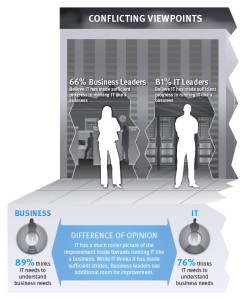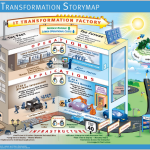This is Part 1 of a 3-part series on the Dual Perspectives of IT and Business Leaders on ITaaS. Click here to view Part 2 and Part 3. To see the whole story told at once, view the Dual Perspectives on ITaaS Journey infographic. Also be sure to read the blog to tell it all.
A recent study by IDG Research shows an interesting dichotomy. IT leaders’ opinions of the progress they’ve made toward ITaaS, (i.e. running IT like a business), denotes that IT has made considerably more progress than their customers, the business leaders. While 81% of IT leaders believe they’ve made substantial progress, only 66% of business leaders think so.
*Mouse over the mini-infographic for an up close look of how the stats tell the story.*So what might cause this disconnect?
One reason that comes to mind is the visibility of IT’s progress to the business. Perhaps IT has made progress – they know what services they offer, they’ve automated some of them, but they haven’t done a good job of communicating that to the business.
 That said, how can you communicate availability of these services in a way that will resonate? By exposing your services in a business-facing portal. For example, a portal allows:
That said, how can you communicate availability of these services in a way that will resonate? By exposing your services in a business-facing portal. For example, a portal allows:
-
- business users to order IT services
- you to filter options by role and policy
- you to display charges and make simple comparisons between internally provided services and those from external service providers
But wait, you say we don’t have our catalog of services completely defined and automated? Don’t let that keep you from showing progress to the business. Even if services are fulfilled manually, you can accomplish a great deal just by creating a storefront for the business. You can take orders that generate a workflow to your staff (rather than have the business make a phone call, or worse yet, go to an outside vendor), and you can show real, visible progress to the business. You can also study the use patterns from your portal and discover which services are most in demand. You can use agile processes to make incremental additions and refine your ideas. You’ll be able to validate and prioritize the services in your catalog based on usage and feedback.
So, don’t wait. Let the business know what progress you’ve made with a self-service portal.
Check out the next installment of the Dual Perspective on ITaaS series here – Part 2: Steps of Progress.
*Click the icons below to explore more*





